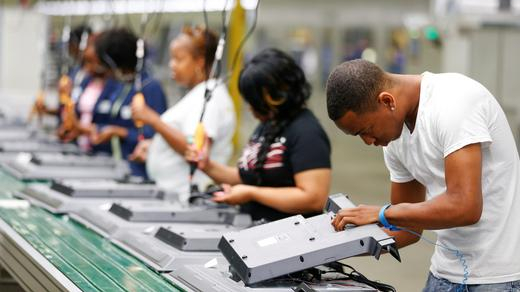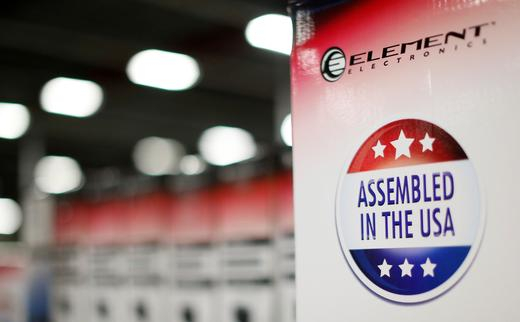

Workers on the assembly line replace the back covers of 32-inch television sets at Element Electronics in Winnsboro, South Carolina, U.S., May 29, 2014. /Reuters Photo
America's trade war with China is once again poised to switch off the nation's last television factory.
The United States had 150 television manufacturers in the 1950s, with factories and suppliers employing hundreds of thousands of workers across the country.
Those sets had hundreds of parts and were often sold in wooden cases the size of kitchen stoves. A modern flat screen, by contrast, has 70 percent of its value packed into the glass panel, and production is now almost entirely in Asia.
Today, there is only one U.S. assembly plant and it is more symbolic than substantive.
Element Electronics opened the plant in an old shirt factory in Winnsboro, South Carolina, in 2014, chiefly to supply televisions to Walmart for the retailer's highly publicized buy-American campaign. It employs 250 workers.
The televisions at the plant are assembled entirely with Chinese components. Element applies the finishing touches in South Carolina, such as the insertion of printed circuit boards. It also tests the sets. Even most of the boxes and other packaging come from China. The labels state: "Assembled in the USA," not "Made in the USA," although the difference is lost on most consumers.
The mostly Chinese origin of these televisions has become a matter of survival for Element for the second consecutive year.

An "Assembled in the USA" stamp is seen at the side of a box containing a 32-inch television set in the warehouse of Element Electronics, in Winnsboro, South Carolina, U.S., May 29, 2014. /Reuters Photo
Last summer, U.S. President Donald Trump's administration announced it would impose tariffs on Chinese television components among the many goods affected by a deepening trade war between the U.S. and China.
The extra cost of the tariffs would mean the plant would not be able to compete on price with televisions imported from Mexico and Asia. Element appealed for relief, arguing that the items should be removed from the tariff list.
The company announced it would have to shut down because of the added cost of tariffs, and notified its workers they were being laid off.
The plant stopped production, but the company won a last-minute reprieve when the U.S. government dropped television parts from its list. In the end, no workers were laid off.
Now the tariff threat is back. Trump's administration is preparing to impose 25 percent tariffs on the last 300 billion U.S. dollars worth of Chinese goods not already covered by trade-war duties. Televisions and components are on the list.
Future in doubt
Trump's meeting with Chinese President Xi Jinping later this week at the G20 summit in Japan could determine whether those tariffs are imposed. In the meantime, the plant's future is again in doubt.
"We'll appeal - our lawyers will work on that," said Michael O'Shaughnessy, the company's chief executive.
Tariffs on Chinese imports are not only part of Element's trade problem. The company has also struggled to compete with television importers from Mexico because of tariff rules.
Mexican television plants also assemble components mostly from Asia. Those TVs are then exported across the U.S. border duty-free because they are included in the North American Free Trade Agreement.
About 40 percent of televisions imported to the U.S. in recent years come from Mexico, according to the U.S. International Trade Commission.
Now, it is the busiest time of year for all television manufacturers, as they gear up for the holiday sales surge at the end of the year.
"We're doing the things we can today to bring in a little more parts than we normally would," said O'Shaughnessy, "So we have a buffer against the unknown."

Copyright © 2018 CGTN. Beijing ICP prepared NO.16065310-3
Copyright © 2018 CGTN. Beijing ICP prepared NO.16065310-3